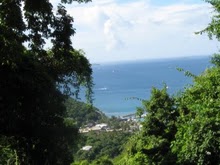The beautiful little red and black bird in the pictures I posted a few days ago is called a White-winged Crossbill. Odd that, because its wings are only edged in white and, although they have white streaks, the wings themselves are black. I had a little trouble identifying this bird, partially because of its name, but also because it looks quite similar to a number of other birds, one of them being the Pine Grosbeak.
Pine Grosbeaks however, as you can see in the photograph below (courtesy of Wikipedia), have a heavy short black bill to help them crack seeds. This bird is also rose red in color, but its wings have more white streaks, and they have gray areas on their chest, as well as below the wings. In addition they have gray patches around their bill, while their tail is long and slightly forked. The Pine Grosbeak is the largest of the finches who inhabit the northern parts of the country.
 |
| Pine Grosbeak |
 |
| White Winged Crossbill |
In comparison the
White-winged Crossbill
has very dark black wings with a couple of clear white streaks, a short black tail underlined with white, and a clear black streak displayed as a crescent on the side of it's head. It's red color is darker and more pronounced, than that of the Pine Grosbeak. Their beak, is lighter in color and has a distinct hook when viewed from the side. This is what helped me to identify the bird in my pictures. You can clearly see a hook on the beak of the bird, in my picture just above if you double click to enlarge it.
The hook on the top half of the beak crosses over the hook of the bottom part of the beak, hence the name crossbill. This specialized beak helps the White-winged Crossbill to dig the seeds out of pine cones. The White Winged Crossbill is also a finch, though smaller than the Pine Grosbeak, and prefers to inhabit boreal and/or coniferous forests. It is labeled as nomadic, since it wanders all over its northern habitat, which ranges from Alaska to Newfoundland, as well as a portion of the states. They fly in large flocks year round, and may on occasion be seen in city parks.
 |
| White winged Crossbill on the ground |
An interesting fact about the White-winged Crossbill is that they call out, thereby drawing attention to themselves, only when food is scarce. It is precisely that which drew me toward the stand of trees where I found and photographed this bird. It has a very distinct voice, one I hadn't heard before. Apparently when food is plentiful they are quiet, and so often remain unseen.
More information on the White-winged Crossbill can be found at the links below, as well as a good video of how this bird digs seeds from pine cones.
http://www.oiseaux-birds.com/card-white-winged-crossbill.html
http://museum.gov.ns.ca/mnh/nature/nsbirds/bns0405.htm
http://www.youtube.com/watch?v=PhlDA2DocXM
http://birdweb.org/birdweb/bird_details.aspx?id=458
Susan















No comments:
Post a Comment